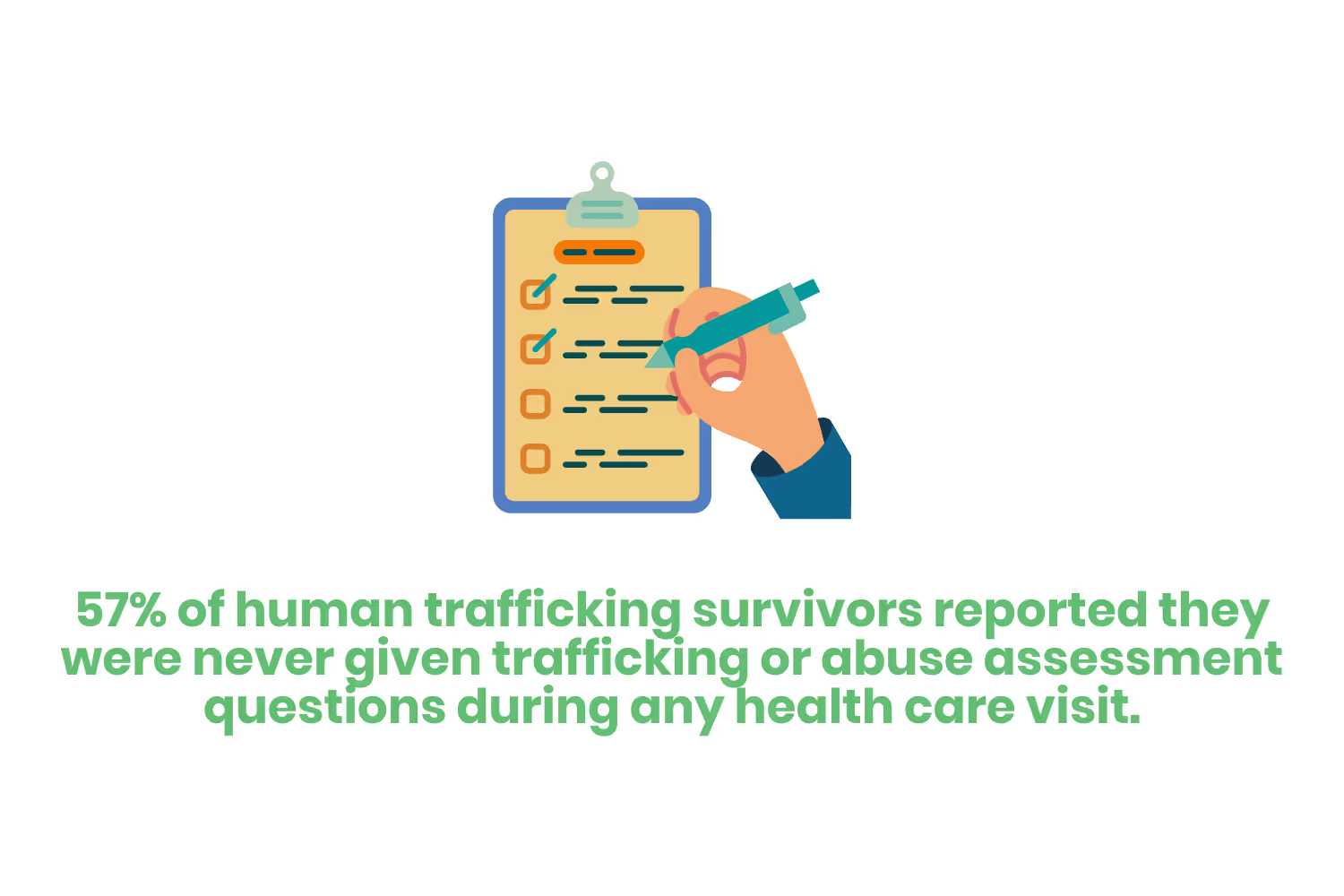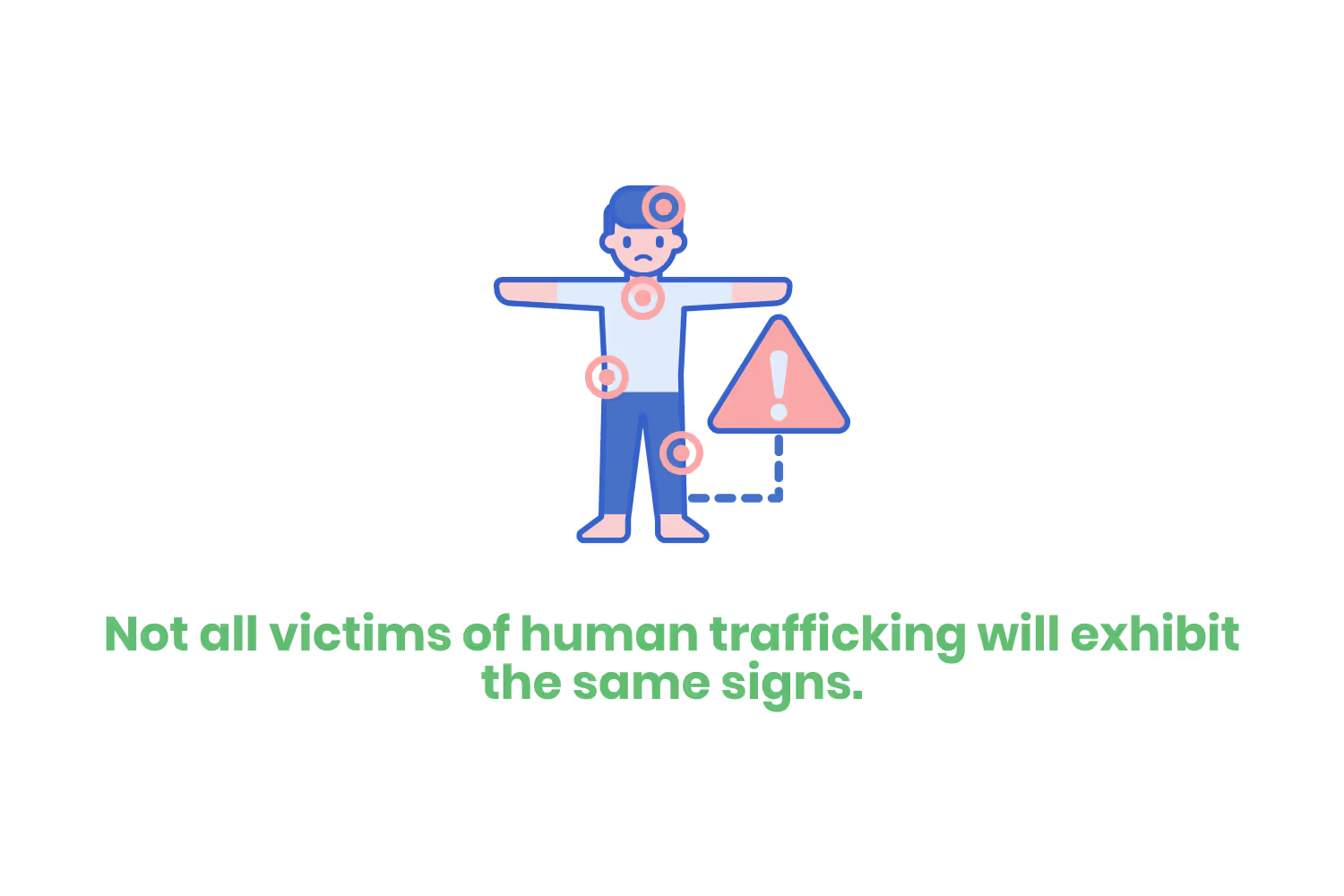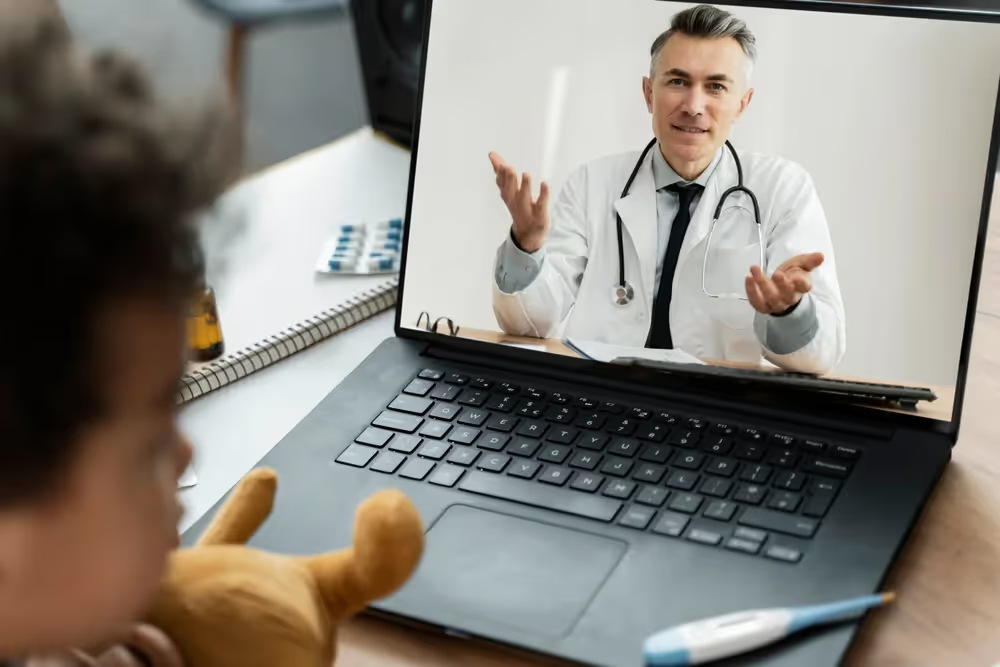Identifying Human Trafficking in Healthcare: What to Look for & What to Do
Let’s take a look at what the red flags and indicators are of human trafficking in a healthcare setting, how to conduct an assessment, what to do if you do identify a potential victim of human trafficking, and who to contact in that situation.

69% of human trafficking survivors surveyed by the Polaris Project reported they had access to health services at some time during their exploitation. 85% said they had received treatment for an illness or injury directly related to their work or exploitation.
As you can see, there are many opportunities for healthcare professionals to intervene in human trafficking situations. However, this isn’t exactly the case.
A 2012 study found that only 6% of healthcare professionals reported treating a human trafficking survivor during their career. 57% of survivors on Polaris’s survey reported they were never given trafficking or abuse assessment questions during any health care visit.

Clearly, there’s room for improvement. But how do we go about identifying human trafficking in healthcare?
The first thing to do is learn about the red fags and indicators that may point to a human trafficking situation. Learn what kind of symptoms, health conditions, verbal and non-verbal cues, and other factors may point to human trafficking.
Let’s take a look at what the red flags and indicators are, how to conduct an assessment, what to do if you do identify a potential victim of human trafficking, and who to contact in that situation.
Human Trafficking Red Flags
The following is a list of potential red flags and indicators of human trafficking that may present themselves when a medical provider sees a victim as a patient.
Each indicator by itself may not imply a trafficking situation. Not all victims of human trafficking will exhibit these signs.
That said, if several indicators are present, this may point to the need for referrals and further assessments.
Let's take a look at identifying human trafficking in healthcare.
General Indicators of Human Trafficking
- Has a scripted or inconsistent explanation for injuries/illnesses
- Shows an unwillingness or is hesitant to answer questions about injuries/illnesses
- There is an individual present with the patient who…
- Does not let the patient speak for themselves
- Refuses to let the patient have privacy
- Interprets for the patient
- There is evidence of a controlling or dominating relationship
- This may present itself with excessive concerns about pleasing a family member, romantic partner, or employer
- Shows fearful or nervous behavior, including avoiding eye contact
- Demonstrates hostile behavior or resists assistance
- Does not know their address
- Does not know their current location, the date, or the time
- Is not in possession of their identification documents
- Does not have control over their own money
- Is not getting their paycheck or has their wages withheld

Labor Trafficking Indicators
- Shows signs of abuse at work
- Mentions threats of harm by an employer or supervisor
- Is not allowed to take adequate breaks while at work
- Is not allowed food or water while at work
- Does not have adequate personal protective equipment for hazardous work
- Mentions the work they are currently doing is not the same as the work mentioned during the recruitment
- Has to live in housing provided by the employer
- Owes the employer or recruiter a debt they can’t pay off
Sex Trafficking Indicators
- The patient is under the age of 18 while involved with the commercial sex industry
- Has tattoos or other forms of branding
- Such tattoos could say “Daddy,” “Property of…,” “For sale,” etc.
- Reports they have an unusually high number of sexual partners
- Doesn’t have appropriate clothing given the current weather or venue
- Uses language commonly used in the commercial sex industry
Indicators and Consequences of Human Trafficking
Before continuing with the list of indicators of human trafficking healthcare providers might find in a patient, you need to know that the following list is not exhaustive.
Trafficking survivors may experience one or more of the indicators below. They might experience none of the indicators listed or some that are not on the list.
Our intention with the list below is to help you assess if a patient’s condition may be a result of a trafficking-related trauma. You should look at the indicators and consider them in context.
Now that we got all of those disclaimers out of the way, let’s continue looking at identifying human trafficking in healthcare.
Physical Health Indicators
- Signs of physical abuse or unexplained injuries
- Bruising
- Burns
- Cuts or wounds
- Blunt force trauma
- Fractures
- Broken teeth
- Signs of torture
- Neurological conditions
- Traumatic brain injury
- Headaches or migraines
- Unexplained memory loss
- Vertigo of unknown etiology
- Insomnia
- Difficulty concentrating
- Cardiovascular/respiratory conditions seemingly caused by or worsened by stress
- Arrhythmia
- High blood pressure
- Acute Respiratory Distress
- Gastrointestinal conditions seemingly caused or worsened by stress
- Constipation
- Irritable bowel syndrome
- Dietary health issues
- Severe weight loss
- Malnutrition
- Loss of appetite
- Reproductive issues
- Sexually-transmitted infections
- Genitourinary issues
- Repeated unwanted pregnancies
- Forced or pressured abortions
- Genital trauma
- Sexual dysfunction
- Retained foreign body
- Substance use disorders
- Other health issues
- Effects of prolonged exposure to extreme temperatures
- Effects of prolonged exposure to industrial or agricultural chemicals
- Somatic complaints
Mental Health Indicators
- Depression
- Suicidal ideation
- Self-harming behaviors
- Anxiety
- Post-traumatic stress disorder
- Nightmares
- Flashbacks
- Lack of emotional responsiveness
- Feelings of shame or guilt
- Hyper-vigilance
- Hostility
- Attachment disorder
- Lack of/difficulty in engaging in social interactions
- Signs of withdrawal, fear, sadness, or irritability
- Depersonalization/derealization
- Feeling like an outside observer of themselves, as if watching themselves in a movie
- Emotional or physical numbness of senses
- Feeling alienated from or unfamiliar with their surroundings
- Distortions in the perception of time
- Dissociative disorders
- Memory loss
- A sense of detachment from themselves
- A lack of a sense of self-identity, or switching between alternate identities
- A perception of the people and things around them as distorted or unreal
Social Developmental Indicators
- Increased engagement in high-risk behaviors, such as running away or early sexual initiation if a minor
- Trauma bonding with a trafficker or other victims (e.g. Stockholm syndrome)
- Difficulty establishing or maintaining healthy relationships
- Delayed physical or cognitive development
- Impaired social skills
Conducting an Assessment
Oftentimes, victims of human trafficking don't disclose their situation in clinical settings. Therefore, it's important for medical practitioners to be thoughtful about engaging patients. Consider employing trauma-informed practices and techniques along with creating a space that is conducive to discussing human trafficking.

Before starting any conversations with a patient, assess the potential safety risks that may result from asking sensitive questions. You need to recognize that the goal of your interaction is not to disclose or rescue. Your goal is to create a safe, non-judgmental place that will help you identify trafficking indicators and assist the patient.
We recommend the following for assessments:
- Allow the patient to decide if they would be more comfortable speaking with a male or female practitioner.
- If the patient needs an interpreter, always use professional interpreters who are not related to the patient or situation
- If the patient is with others in the waiting room, find a time and place to speak with the patient privately
- Take the time to build rapport with potential victims
- If you don’t have the time yourself, find someone else on your staff who can develop rapport with the patient.
- Ensure that the patient understands confidentiality policies and practices
- This includes mandatory reporting laws
- Use multidisciplinary resources, such as social workers, where available
- Refer to existing institutional protocols for victims of abuse or sexual abuse
- Contact the national human trafficking hotline for assistance in conducting an assessment and determining the next steps.
- You should do this if you don’t already have a protocol developed to respond to victims of human trafficking.
What to do if you identify a potential victim
Every situation of human trafficking is different. It’s important to use a victim-centered response when you encounter human trafficking on the job.
Not all victims of human trafficking will be comfortable disclosing their situation. Victims might not be ready to seek assistance from service providers, law enforcement, or medical professionals.

However, medical providers have a unique opportunity. They can provide potential trafficking victims with information and options. They can support victims through the process of connecting with advocates or service providers if they are ready to report their situation.
Here are some things you should do if a patient discloses that they are in a trafficking situation…
- Provide the victim with the National Human Trafficking Hotline Number. Encourage them to call if they want help or want to talk to someone. If the patient feels it is dangerous to have something with the hotline number on it, have them memorize the number.
- If the victim is in immediate, life-threatening danger, follow your institutional policies for reporting to law enforcement. If possible, make an effort to partner with the patient in the decision to contact law enforcement.
- Provide the patient with options for services, resources, and reporting. Make sure to include safety planning in the discharge planning process.
- If the patient is an adolescent or child, follow mandatory state reporting laws and institutional policies related to child abuse or serving unaccompanied youth.
- Make sure that any information regarding the patient’s injuries or treatment is accurately documented in the patient’s records. While such documentation may be helpful in building a criminal case against a trafficker, information about the victim may be necessary for court proceedings.
Who to Contact
The legal requirements regarding mandatory reporting of human trafficking might vary from state to state. Situations may require mandatory reporting under related statutes even if the situation does not involve human trafficking. For example, you need to report child abuse or domestic violence.
Refer to your local and state requirements regarding mandatory reporting. Contacting the National Human Trafficking Hotline will not fulfill the mandatory reporting requirements. That said, the Hotline can facilitate a report to specialized law enforcement trained to handle human trafficking cases.

When working with adults in trafficking situations, it’s important to gain permission and consent from the patient before disclosing any personal information to others. This includes disclosing information to service providers.
Furthermore, medical providers should also consider how HIPAA regulations may impact a healthcare provider’s ability to report potential trafficking situations on behalf of the patient. When contacting the Hotline or connecting with local service providers, keep in mind any confidentiality obligations.
Conclusion
Human trafficking in healthcare will look a little different depending on what kind of doctor you are and the victim’s situation. No two cases of human trafficking are quite the same.
The best way to fight against human trafficking in the healthcare space is to learn what it looks like. Learn about the symptoms of trafficking and how they might present themselves in the exam room.
Once you identify a situation as being a potential trafficking arrangement, you need to know what to do. We covered a little bit of what to do above, but you might not know what steps to take at the moment when a victim is sitting in front of you.
This is why training healthcare staff about human trafficking is so vital. If you would like to purchase human trafficking training for healthcare employees, click here.
Emphasize your product's unique features or benefits to differentiate it from competitors
In nec dictum adipiscing pharetra enim etiam scelerisque dolor purus ipsum egestas cursus vulputate arcu egestas ut eu sed mollis consectetur mattis pharetra curabitur et maecenas in mattis fames consectetur ipsum quis risus mauris aliquam ornare nisl purus at ipsum nulla accumsan consectetur vestibulum suspendisse aliquam condimentum scelerisque lacinia pellentesque vestibulum condimentum turpis ligula pharetra dictum sapien facilisis sapien at sagittis et cursus congue.
- Pharetra curabitur et maecenas in mattis fames consectetur ipsum quis risus.
- Justo urna nisi auctor consequat consectetur dolor lectus blandit.
- Eget egestas volutpat lacinia vestibulum vitae mattis hendrerit.
- Ornare elit odio tellus orci bibendum dictum id sem congue enim amet diam.
Incorporate statistics or specific numbers to highlight the effectiveness or popularity of your offering
Convallis pellentesque ullamcorper sapien sed tristique fermentum proin amet quam tincidunt feugiat vitae neque quisque odio ut pellentesque ac mauris eget lectus. Pretium arcu turpis lacus sapien sit at eu sapien duis magna nunc nibh nam non ut nibh ultrices ultrices elementum egestas enim nisl sed cursus pellentesque sit dignissim enim euismod sit et convallis sed pelis viverra quam at nisl sit pharetra enim nisl nec vestibulum posuere in volutpat sed blandit neque risus.

Use time-sensitive language to encourage immediate action, such as "Limited Time Offer
Feugiat vitae neque quisque odio ut pellentesque ac mauris eget lectus. Pretium arcu turpis lacus sapien sit at eu sapien duis magna nunc nibh nam non ut nibh ultrices ultrices elementum egestas enim nisl sed cursus pellentesque sit dignissim enim euismod sit et convallis sed pelis viverra quam at nisl sit pharetra enim nisl nec vestibulum posuere in volutpat sed blandit neque risus.
- Pharetra curabitur et maecenas in mattis fames consectetur ipsum quis risus.
- Justo urna nisi auctor consequat consectetur dolor lectus blandit.
- Eget egestas volutpat lacinia vestibulum vitae mattis hendrerit.
- Ornare elit odio tellus orci bibendum dictum id sem congue enim amet diam.
Address customer pain points directly by showing how your product solves their problems
Feugiat vitae neque quisque odio ut pellentesque ac mauris eget lectus. Pretium arcu turpis lacus sapien sit at eu sapien duis magna nunc nibh nam non ut nibh ultrices ultrices elementum egestas enim nisl sed cursus pellentesque sit dignissim enim euismod sit et convallis sed pelis viverra quam at nisl sit pharetra enim nisl nec vestibulum posuere in volutpat sed blandit neque risus.
Vel etiam vel amet aenean eget in habitasse nunc duis tellus sem turpis risus aliquam ac volutpat tellus eu faucibus ullamcorper.
Tailor titles to your ideal customer segment using phrases like "Designed for Busy Professionals
Sed pretium id nibh id sit felis vitae volutpat volutpat adipiscing at sodales neque lectus mi phasellus commodo at elit suspendisse ornare faucibus lectus purus viverra in nec aliquet commodo et sed sed nisi tempor mi pellentesque arcu viverra pretium duis enim vulputate dignissim etiam ultrices vitae neque urna proin nibh diam turpis augue lacus.




